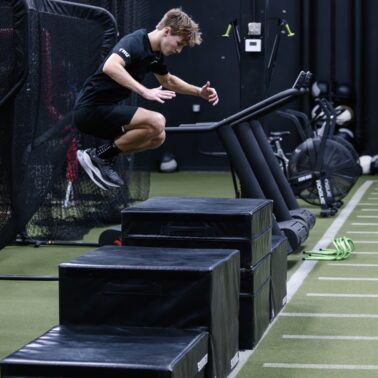“Isometric training is a powerful tool that can not only be a great starting point for strength training during sports rehab, but also a valuable tool to enhance performance during high stress periods of a sports season.”
Adam Loiacono
What You Will Learn
- How isometrics help reduce pain during rehab.
- Yielding vs overcoming isometrics.
- The role isometrics have in motor learning and mastering joint positions.
Isometric exercise is a modality that has regained popularity in the last several year in the performance training space. This mode of exercise offers great value during both rehab and sports training. Isometrics offer multiple uses and often times do not produce as much delayed onset muscle soreness (DOMS) as traditional exercise produces.
What is Isometric Exercise?
Isometric exercise refers to a type of strength training where muscle contraction occurs without any joint movement or change in muscle length. During isometric exercises, the muscle exerts force against an immovable object or resists a force applied externally. For example, we can either use the barbell back squat to push the barbell into fixed pins or we can add weight to bar simply hold the barbell at a specific depth.
Yielding Isometrics vs. Overcoming Isometrics
Yielding isometrics are the act of resisting against a very heavy external load. This mode of isometrics have shown to produce similar adaptations as traditional eccentric exercise yet without the residual DOMS that follows traditional eccentrics. Imagine a barbell back squat with 120% of your 1 rep max and your fighting for your life to resist the weight from lowering you
On the other hand, overcoming isometrics involve exerting maximum force against an immovable object. This type of isometric exercise focuses on building maximal strength and is similar to traditional concentric exercise. I view yielding isometrics as a modality to improve deceleration qualities while overcoming isometrics to improve acceleration qualities.
Modulation of Pain through Isometric Exercise
Isometric exercise has demonstrated remarkable efficacy in modulating pain, making it an invaluable tool in sports rehab. When performed correctly, isometrics can help reduce pain and improve functional outcomes in patients with various musculoskeletal conditions.
One possible explanation for the pain-relieving effects of isometric exercise is the activation of the descending pain inhibitory pathway. Isometric contractions engage a large number of motor units, leading to the release of endogenous opioids and activating the body’s natural pain-suppressing mechanisms.
Mastering Joint Positions
Additionally, isometrics promote muscular stabilization, which can alleviate pain by providing support to the affected joints and structures. Strengthening the muscles surrounding a painful joint helps offload stress and improve joint mechanics, ultimately reducing pain and enhancing functional capacity.

Isometric exercises are particularly effective in strengthening muscles at specific joint angles, making them a valuable tool in physical therapy interventions. By targeting specific joint positions, isometrics help address specific strength deficits and learn good biomechanics
Multi-Angle Isometrics
Isometric exercises can be performed at multiple joint angles to strengthen muscles throughout their entire range of motion. This approach is especially useful for individuals with limited mobility or joint restrictions. By working at different joint angles, isometrics allow for targeted muscle activation and strengthen muscles in positions where they are most vulnerable or weak.
For example, in the case of knee rehabilitation, isometric exercises performed at varying degrees of knee flexion target the quadriceps muscles differently. Specific joint angles can be selected based on individual needs and pathology to enhance muscle recruitment and strength gains.
Moreover, isometric exercises in weight-bearing positions contribute to functional strength and stability. Incorporating functional activities such as squats or lunges into isometric training helps replicate athletic movements and challenges the muscles to stabilize the joints during weight-bearing activities.
Summary
Isometric exercise is a powerful tool in physical therapy that aids in pain modulation, muscle strengthening, and joint stability. Understanding the differences between yielding and overcoming isometrics, as well as their application in specific joint positions, enables physical therapy students to design effective rehabilitation programs tailored to individual patient needs. Mastering the principles and applications of isometric exercise will enhance your ability to provide effective sports rehab. Ultimately isometrics will improve the return to play process and help athletes return to sport quicker.



